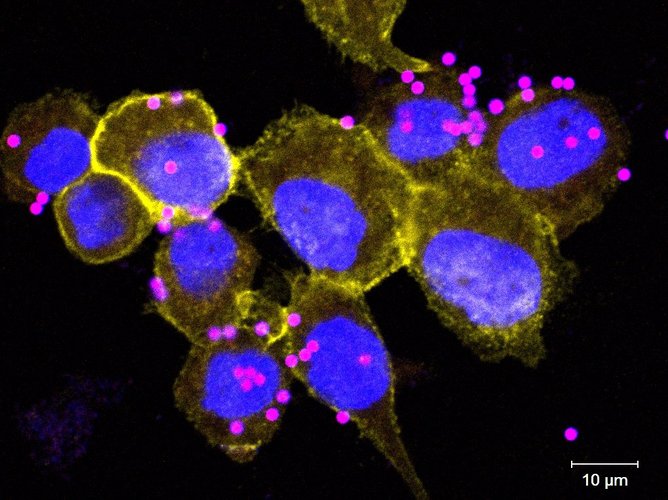How immune cells kill bacteria with acid
Share
The first line of immune defense against invading pathogens like bacteria are macrophages, immune cells that engulf every foreign object that crosses their way and kill it with acid, in a process called phagocytosis. In their quest to systematically study proteins that transport chemicals across cellular membranes, researchers at CeMM characterized the critical role for transporter SLC4A7 in this process, providing valuable new insights for many pathologic conditions from inflammation to cancer. Their results were published in Cell Host & Microbe.
Among the many different kinds of immune cells that patrol the body, macrophages are the first when it comes to fight against a foreign threat. With their flexible and versatile surface, they engulf every microorganism or particle that could be harmful for the health of the organism, and enclose it in an intracellular membrane vesicle called phagosome. To eliminate the threat and break it down to its constituents, the interior of the phagosome needs to be effectively and progressively acidified. For this crucial part of phagocytosis, the macrophages must undergo multiple metabolic changes, which are not yet entirely understood.
The team of Giulio Superti-Furga, Scientific Director of CeMM, in collaboration with the laboratory of Nicolas Demaurex of the University of Geneva, discovered in their latest study that a membrane protein belonging to the family of “solute carriers” (SLCs) plays an essential role in phagocytosis and phagosome acidification. Their work was published in the journal Cell Host & Microbe (DOI 10.1016/j.chom.2018.04.013).
The researchers developed an essay with special cells in which they impaired the 391 human SLC genes individually using CRISPR/Cas9 gene editing technology. Strikingly, among all SLCs, SLC4A7, a sodium bicarbonate transporter, was the only one who turned out to be essential for macrophages to undergo phagocytosis and acidification. Cells with impaired SLC4A7 were unable to acidify their phagosomes and by consequence decreased their capacity to kill bacteria.
The results of this study do not only provide new fundamental insights into the molecular functioning of one of the most important cells of the immune system. As phagocytosis plays a significant role in various pathologic conditions from inflammation to cancer, these new insights are likely of relevance beyond the context of infectious diseases. The effort to understand the role of the different cellular transporters, supported by a grant of the European Research Council (ERC), has added a small new piece to the large and fascinating puzzle coupling trafficking of chemical matter to metabolism and cellular function.
Publication:
Vitaly Sedlyarov, Ruth Eichner, Enrico Girardi, Patrick Essletzbichler, Ulrich Goldmann, Paula Nunes-Hasler, Ismet Srndic, Anna Moskovskich, Leonhard X. Heinz, Felix Kartnig, Johannes W. Bigenzahn, Manuele Rebsamen, Pavel Kovarik, Nicolas Demaurex, and Giulio Superti-Furga. The Bicarbonate Transporter SLC4A7 Plays a Key Role in Macrophage Phagosome Acidification. Cell Host & Microbe, 2018. DOI: 10.1016/j.chom.2018.04.013
Funding
The study was funded by the European Research Council (ERC), the Austrian Academy of Sciences, the Austrian Science Fund (FWF), the European Commission, and the European Molecular Biology Organization (EMBO).

